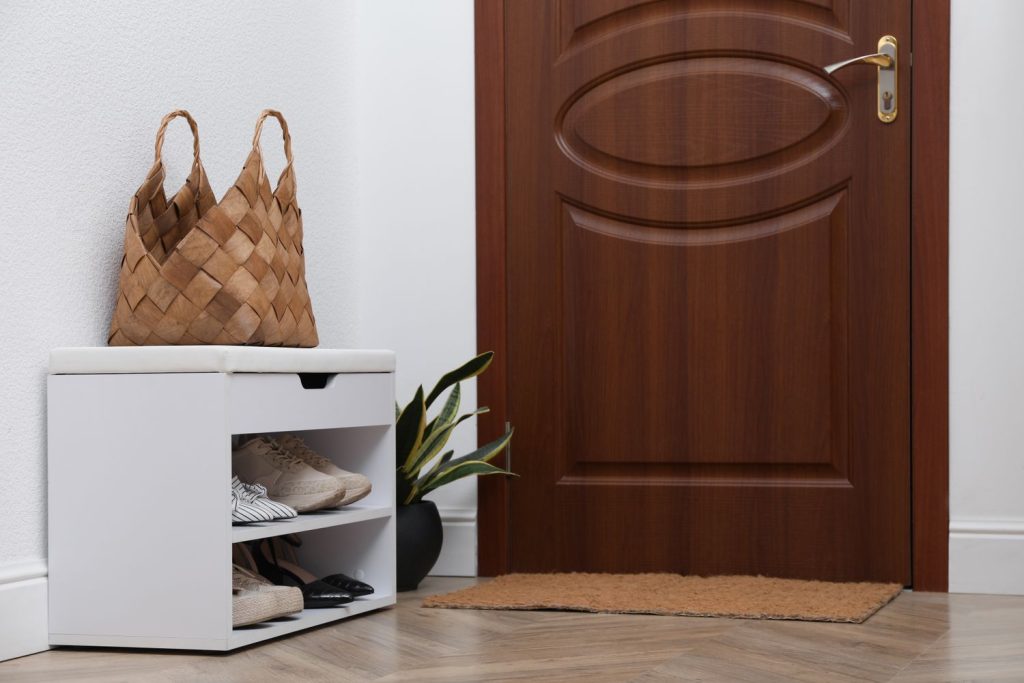:max_bytes(150000):strip_icc():format(jpeg)/GettyImages-1407503073-b607d1e07a2941d2aa38912009efeae0.jpg)
If you grew up in a shoes-on household, you may not think twice about walking around your home in your outdoor shoes. While taking shoes off at the door is commonplace in many parts of the world, it’s less ubiquitous in American culture, with only 31% of Americans reporting that they “always” take off their shoes at home, according to YouGov polls. However, this practice is more than just a matter of personal preference or cultural norms—it’s also a matter of health and safety, since shoes can track in dirt and bacteria from outside. If you’re still not convinced you shouldn’t be wearing your outdoor shoes inside your home, here are some reasons that might cause you to reconsider.
Dirt and Bacteria Gets Tracked In
As mentioned, your outdoor shoes can track dirt and bacteria into your home, causing your home to get more dirty more quickly and potentially causing you to get sick. While you probably wouldn’t wear visibly dirty shoes indoors—like after you’ve walked in mud or stepped in something unsavory—you can’t always see what’s hanging on to the bottom of your shoes. Several studies have shown that harmful bacteria is often present on the outside of shoes. In a study done by the University of Arizona, the study found that bacteria can be tracked a long distance into the home by shoes—and 96% of the shoes tested positive for coliform bacteria, which is commonly found in fecal matter.
More Allergens Enter Your Home
Your shoes can also track in a number of allergens from outside, like tree and grass pollen. If you or other members of your household have allergies or asthma, tracking these allergens inside can lead to heightened symptoms and make your home less comfortable. This is a compelling reason to leave your shoes at the door, especially during times when outdoor allergy levels are high.
Lead Could Be Coming In, Too
Thanks to the EPA, federal law requires that homebuyers and renters are informed of the presence of lead-based paint and lead-based paint hazards before the sale or lease of most housing built before 1978. So,you’re probably in the know about whether or not your home has any lead-based paint in it. What you may not know, however, is that you could be tracking lead into your home from your footwear. The EPA notes that outdoor soil can be contaminated with lead and other heavy metals for a number of reasons—including from the past use of leaded gasoline in cars, from industrial sources, or from contaminated sites—so the agency recommends removing shoes at the door and using dust mats to avoid tracking lead dust inside your home.
Your Floors Can Get Damaged
Not only can shoes track in unwanted contaminants that can dirty up your floors, but they can also cause more damage that isn’t as easy to wipe away. Certain hard soles and heeled shoes can scratch hardwood floors—and even with softer shoes, small stones or other objects can get stuck in the soles and lead to scratches on your floors. Wearing indoor-only shoes or slippers inside can be a more gentle alternative to protect your floors from damage.
Keeping Your Shoes On Is Less Relaxing
For many of us, coming back home after a long day out is like a sigh of relief, and changing into cozy clothes is an important part of getting comfy and relaxing. Taking off your shoes at the door and changing into slippers or a pair of house shoes can be a comforting way to transition from productive mode to chill mode when you get home.

